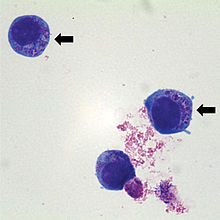Human granulocytic anaplasmosis
| Classification according to ICD-10 | |
|---|---|
| A77.8 | Other tick bite fever |
| ICD-10 online (WHO version 2019) | |
The human granulocytic anaplasmosis (HGA) is a by phagocytophilum Anaplasma caused bacterial infection of humans. It was formerly known as Human Granulocytic Ehrlichiosis (HGE).
The disease was first described in the 1990s in Wisconsin in the American Midwest , the region with the highest number of cases.
transmission
It is transmitted to humans through tick bites . The most common vector in Europe is the wood tick ( Ixodes ricinus ), in North America mainly Ixodes scapularis and Ixodes pacificus . Protection against ticks is therefore also infection prophylaxis.
Epidemiology
Ticks infected with Anaplasma phagocytophilum and patient sera that contain antibodies against this bacterium have been found in many European countries (including Belgium, Germany, England, France, Great Britain, Italy, the Netherlands, Norway, Sweden, Austria, the Switzerland and Slovenia).
In southern Germany, 1.6 to 4% of adult Ixodes ricinus ticks are infected. The prevalence of antibodies that confirm previous contact with the pathogen is 1.9 to 2.6% in Germany. In risk groups such as forest workers or foresters, it is significantly higher at 11.4 to 18.4%.
Nevertheless, no confirmed case of an acute illness of human granulocytic anaplasmosis is known in Germany. Case reports from the USA, Austria, Slovenia, Portugal, Belgium and Italy are available.
Human granulocytic anaplasmosis is much more common in the USA. There it is mainly in the upper Midwest and in the northeast . Since 2000 there has been a steady increase in the number of cases in these two regions.
Since Anaplasma phagocytophilum also affects dogs (→ Canine Anaplasmosis ), ruminants, cats and horses, they represent a reservoir of pathogens.
clinic
67 to 75% of all infections are asymptomatic . After an incubation period of around 5 to 30 days, however, a high fever and flu-like symptoms with headache, limb pain, muscle and joint pain can occur. Abdominal pain, nausea, vomiting and diarrhea are also rare . Dry cough and rashes have also been described.
Dreaded as serious complications are multiple organ failure, meningoencephalitis and acute respiratory distress syndrome, which occur mainly in immunosuppressed patients ( HIV , organ transplantation ). The lethality of symptomatic anaplasmosis is 2 to 3%.
Diagnosis

Even without clinical symptoms, typical laboratory changes can be found in 86% of all infected people. In addition to an increase in liver transaminases, this also includes leukocytopenia with lymphopenia and neutropenia, and thrombopenia . C-reactive protein (CRP) and blood sedimentation are increased. The creatine kinase may be increased.
If anaplasmosis is suspected, the microscopic direct detection of morulae in the blood smear, the detection of specific DNA by means of PCR , the cultivation in cell culture and the detection of antibodies by means of an immunofluorescence test are carried out. Subsequent titer tests cannot be used as controls, because antibodies can persist long after the pathogen has been eliminated. A PCR test is somewhat more reliable, but it is also not completely reliable.
therapy
The drug of choice is doxycycline . In humans, 100 mg twice a day is recommended for two to three weeks. If doxycycline is contraindicated, rifampicin can be administered.
literature
- FD von Loewenich and others: Ehrlichiosis - the unknown tick disease. In: The family doctor. 10/01, pp. 39-41.
- FD von Loewenich et al: A Case of Equine Granulocytic Ehrlichiosis Provides Molecular Evidence for the Presence of Pathogenic Anaplasma phagocytophilum in Germany. In: Eur J Clin Microbiol Infect Dis. (2003) 22, pp. 303-305.
- G. Walder et al .: Human granulocytic anaplasmosis in Austria: epidemiological, clinical, and laboratory findings in five consecutive patients from Tyrol, Austria. In: Int J Med Microbiol. 2006 May; 296 Suppl 40, pp. 297-301.
- G. Walder et al: First documented case of human granulocytic ehrlichiosis in Austria. In: Wien Klin Wochenschr. 2003 Apr 30; 115 (7-8), pp. 263-266.
Individual evidence
- ↑ N. Ohashi et al.: Anaplasma phagocytophilum - infected ticks, Japan. In: Emerg Infect Dis . (2005) online , accessed May 8, 2007.
- ↑ JS Dumler et al.: Human Granulocytic Anaplasmosis and Anaplasma phagocytophilum . (online at: medscape.com , 2005, accessed May 8, 2007)
- ↑ David B. Sykes, Eric W. Zhang, Rebecca S. Karp Leaf, Valentina Nardi, Sarah E. Turbett: Case 10-2020: An 83-Year-Old Man with Pancytopenia and Acute Renal Failure ; New England Journal of Medicine 2020, Volume 382, Issue 13 March 26, 2020, Pages 1258-1266, DOI: 10.1056 / NEJMcpc1916250
